Table of Contents
What is Reproduction?
Reproduction is the formation of new young ones by the grown-up individuals so as to produce a new generation or progeny. Members of the new progeny or generation are broadly similar to their parents except for size.
Basic Features of Reproduction:
All modes of reproduction have some common basic features. These are as follows-
- Synthesis of RNA, proteins and other biochemicals.
- Replication of DNA.
- Cells undergo division by mitosis or meiosis.
- Growth of cells.
- Formation of reproductive units like blastos (asexual mode) and gametes (sexual mode).
- Formation of new individuals from reproductive units.
Types of Reproduction:
Mode of reproduction depends upon the structural complexity, physiology and habitat of the organisms. It is of two main types, asexual and sexual.
Asexual Reproduction:
It is that type of reproduction in which there is no formation and fusion of gametes. Here, offspring produced are identical and represent the exact copies of their parents. Such groups of morphologically and genetically similar individuals are called clones, while individuals are called ramets. Apomixis is the formation of new individuals through asexual reproduction without involving the formation and fusion of gametes. Asexual reproduction is frequent in single-celled organisms and in plants and animals, with relatively simple organisations.
Development of an organism from non-sexual reproduction units like buds, fragments etc., is called blastogenesis, while the asexual reproductive body is called blastos.
Features of Asexual Reproduction:
- Only a single organism multiple to produce the offsprings (uniparental reproduction).
- The new offspring arise from the somatic cells of the parent body (somatogenic reproduction).
- The new offsprings remain identical to their parents (clone).
- There is no formation of a union of sex cells.
- All the divisions occurring during asexual reproduction are mitotic and hence no variations are observed in the offspring.
- It does not play any role in evolution.
- Multiplication occurs rapidly.
- Amongst animals, asexual reproduction occurs in Protista, Porifera, Coelenterates, Platyhelminthes and Urochordates. It is absent in higher invertebrates (Arthropoda, Annelida, Mollusca, Echinodermata) and vertebrates (Pisces, Amphibians, Reptiles, Aves and Mammals).
Types of Asexual Reproduction:
It takes place by the following ways-
- Fission.
- Budding.
- Fragmentation.
Fission:
The fission is the most widely occurring type of asexual reproduction of the protozoans and various metazoans. In this method, the nuclear and cytoplasmic contents of the cell divide or split completely into smaller-sized daughter individuals. The fission itself may be of following types-
- Binary Fission.
- Multiple Fission.
- Plasmotomy.
Binary Fission:
In this process of asexual reproduction, the parent organism divides into two halves, each half forming an independent daughter organism. Binary fission involves mitosis. The resultant offspring are genetically identical to the parent and to each other.
On the basis of the plane of division, binary fission is of following types-
- Irregular Binary Fission: There is no fixed plane for the division. However, it occurs at right angles to the nucleus. Example– Amoeba.

- Longitudinal Binary Fission: It begins from the region of anterior extremity and proceeds posteriorly lengthwise. It is preceded by nuclear division. A parent divides into two young ones. Example– in flagellates (Euglena).

- Transverse Binary Fission: Parent is transversely divided into two young ones. Example– Paramecium, Planaria, diatoms and bacteria. In Paramecium the meganucleus divides by amitosis, while micronucleus divides by mitosis.
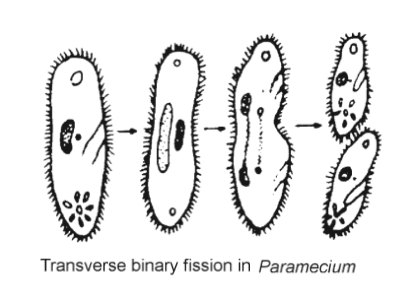
- Oblique Binary Fission: It occurs in dinoflagellates.
- Strobilation: In certain metazoan animals a special type of transverse fission known as the strobilation occurs. In the process of the strobilation, several transverse fissions occur simultaneously and giving rise to a number of individuals which often do not separate from each other immediately. The strobilation occurs in the scyphozoan (Aurelia), certain polychaetes and ascidians. In Aurelia, for instance, strobilation occurs during the formation of ephyra larva.
Multiple Fission:
It is that type of asexual reproduction in which the parental body divides into many daughter cells simultaneously during the unfavourable conditions to increase the chances of survival of daughter cells. In this, the reproductive unit is the whole parental body. Example– Plasmodium, Amoeba.
- Plasmodium: It is a sporozoan, where multiple fission takes place in Schizont (active adult) and Sporont (oocyte) stages. Schizont undergoes division inside the human being resulting into the formation of stages a number of cryptozoites, micro cryptozoites, macro cryptozoites, merozoites, etc. by the process of schizogony while oocyte divides inside the female anopheles resulting into many sporozoites, by the process sporogony.
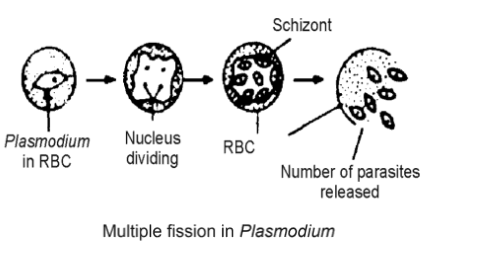
- Amoeba: During the unfavourable environment, there is cyst formation around the Amoeba. Inside the cyst, karyokinesis takes place to form many nuclei. It is later on followed by cytokinesis. By this way, many amoebulae are produced. They are also named pseudopodeospores. As soon as the favourable environment commences, the cyst will dissolve, liberating the amoebulae free. This mode of multiple fission is also called as sporulation.
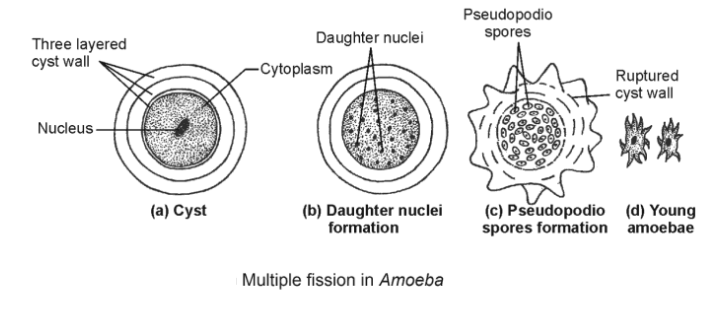
Plasmotomy:
Multinucleated parent divides into many uninucleate daughters by cytokinesis. Later on, each daughter cell undergoes many karyokineses to become multinucleate. Example– Opalina, Pelomyxa (Gaint Amoeba).
Budding:
It is that type of asexual reproduction in which one or more unicellular or multicellular outgrowth, called buds, are formed on or inside the parental body. Each multicellular outgrowth enlarges, develops the parental characters and then separates to lead an independent life. It feeds, grows, becomes an adult and repeats the process. Example– Sponges (Scypha), coelenterates (Hydra), annelids (Syllis), tunicates (Salpa) etc.
- External Budding: Buds develop on the external surface of the parent body, separate and get settled on the substratum to become adults. Example– Scypha, Hydra. If the bud remains attached to the parent body and grows, it will result in the formation of a colonial organism. However, if detached, the organism remains solitary.
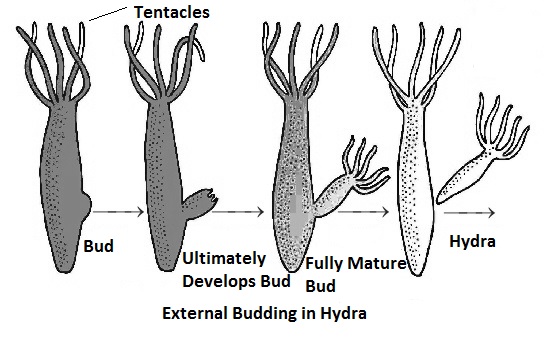
- Internal Budding: Buds develop inside the parent body, detach, come out from the osculum and settle on the substratum to form daughter. Such an internal bud is called gemmule. Internally gemmules contain archaeocytes, which are totipotent cells. It is a very common phenomenon in freshwater sponges.
Fragmentation:
It is that type of asexual reproduction in which the parental body breaks into two or more fragments either by wave action (example- sponges) or by death and decay of old parts. Each body fragment develops into an organism. It is found in some flatworms (Microstomum), sea anemones among coelenterates, and echinoderms. In starfish, even one arm with a part of the central disc can develop into the whole animal.
Spore Formation (Sporulation):
Spores are small, microscopic, unicellular structures that contain a nucleus surrounded by cytoplasm and are capable of forming new individuals on the return of favourable conditions. Unicellular protists like sporozoans example- Monocystis and Plasmodium, typically exhibit sporulation in their life cycle. Spore formation is also common in algae and fungi.
Thus spores are special asexual reproductive structures, that may be motile (zoospores) or non-motile (sporangiospores, conidia).
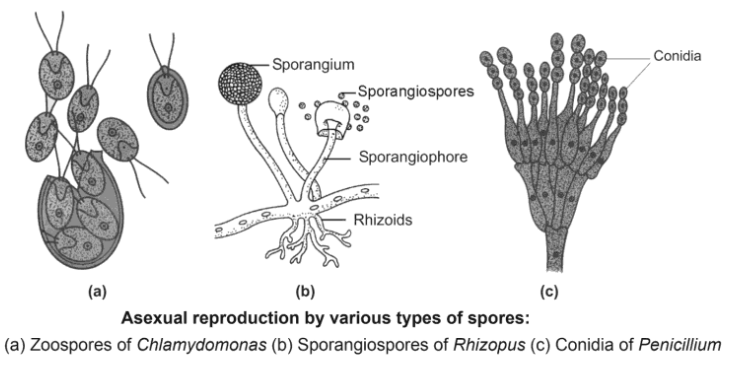
zoospores:
- They are a special type of motile and flagellated spores that are produced inside zoosporangia.
- The zoospores are normally without a cell wall. The flagella help them to swim in an aquatic habitat for proper dispersal.
- The reproduction by zoospores occurs in Chlamydomonas or some lower fungi like Albugo, Phytophthora etc.
sporangiospores:
- They are non-motile spores produced inside the sporangia.
- They are generally dispersed by wind and germinate into a new mycelium.
- The reproduction by sporangiospores occurs in fungi like Rhizopus and Mucor.
Conidia:
- These are non-motile spores produced exogenously by a constriction at the tips of special hyphal branches known as conidiophores.
- The conidiophores may be branched or unbranched. They produce conidia singly as in Phytophthora or in chains as in Aspergillus and Penicillium.
- Conidia may be unicellular (example- Penicillium) or multicellular (example- in Cercospora, Alternaria).
- The conidia may germinate directly to produce mycelium or may produce zoospores which upon germination produce mycelium. The latter type of conidia is called conidiosporangia.
Vegetative Propagation:
In plants, the asexual reproduction occurs by vegetative propagation where new plants develop from any portion of Vegetative organs of plant. The runner, rhizome, sucker, tuber, offset, bulb are all capable of giving rise to new offspring and these structures are called vegetative propagules.
Significance of Asexual Reproduction:
Advantages:
- It involves only a single parent for the production of offspring i.e. uniparental reproduction.
- It involves simple processes of divisions, amitosis or mitosis.
- It is a rapid mode of reproduction.
- Only a single parent may produce a large number of offspring.
- The young ones are genetically similar to their parent.
- It helps in the dispersal of the offspring to far off places.
- It is merely a process of propagation.
Disadvantages:
- As there is rapid multiplication, a large number of young ones are formed. It causes overcrowding.
- Since fusion of gametes is not involved in it, hence genetic recombination, interaction etc. do not occur. Therefore, no variation is caused in the offsprings.
- There is no crossing over. New linkages are not formed.
- It is never concerned with evolution.
- The organisms produced through asexual reproduction have low adaptability to the changing environment.


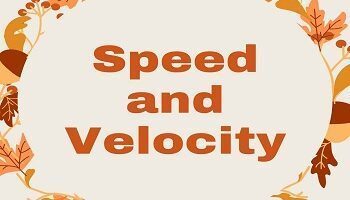






Comments (No)